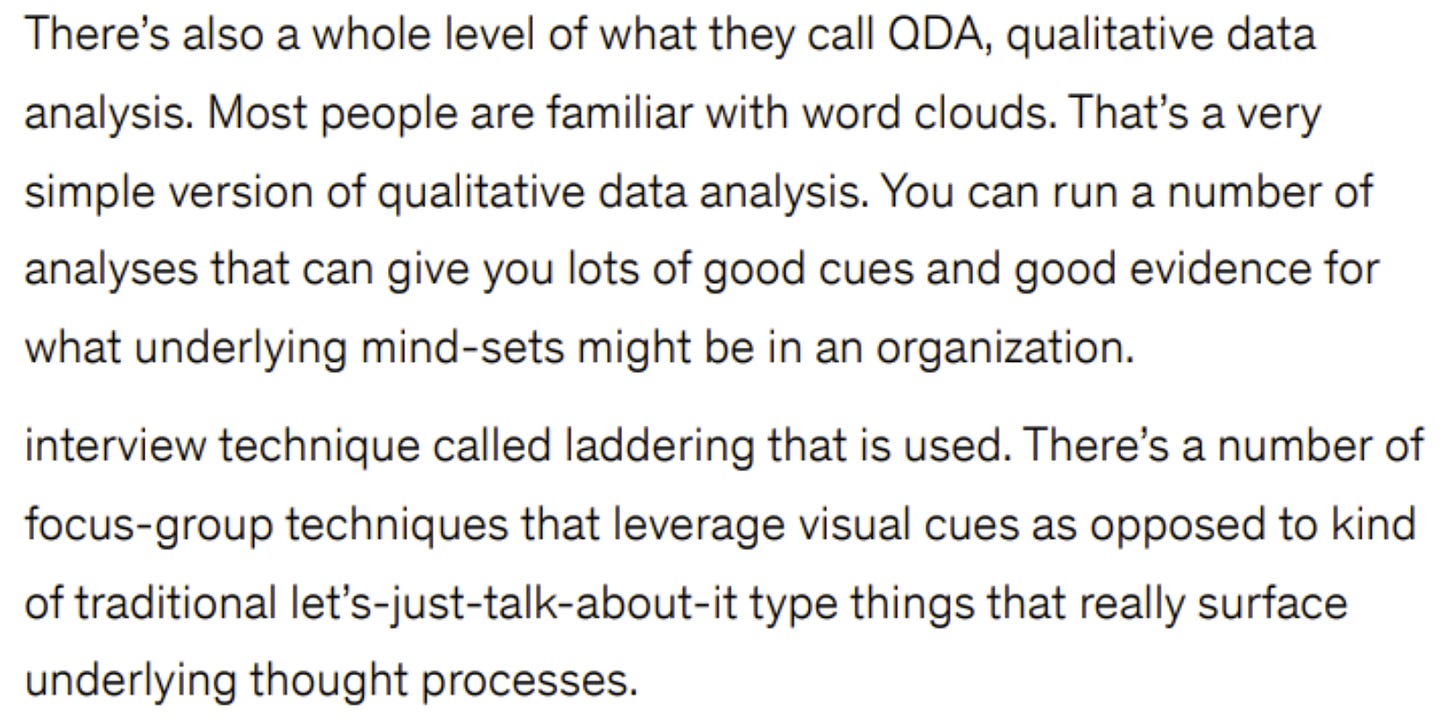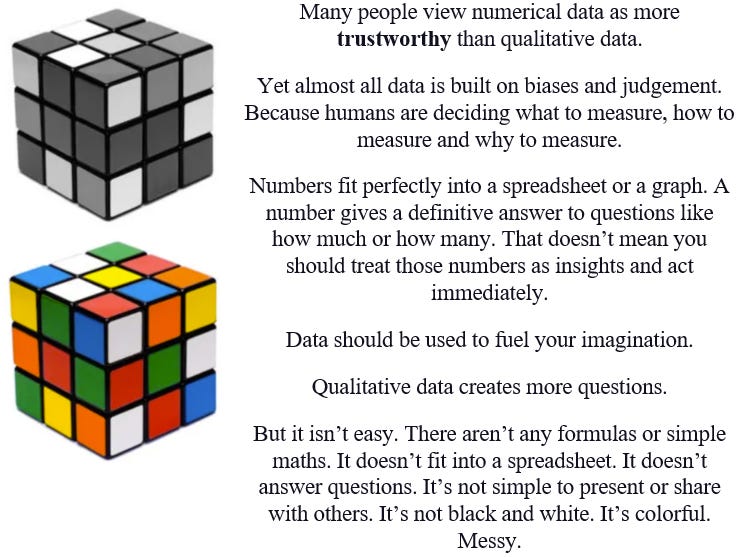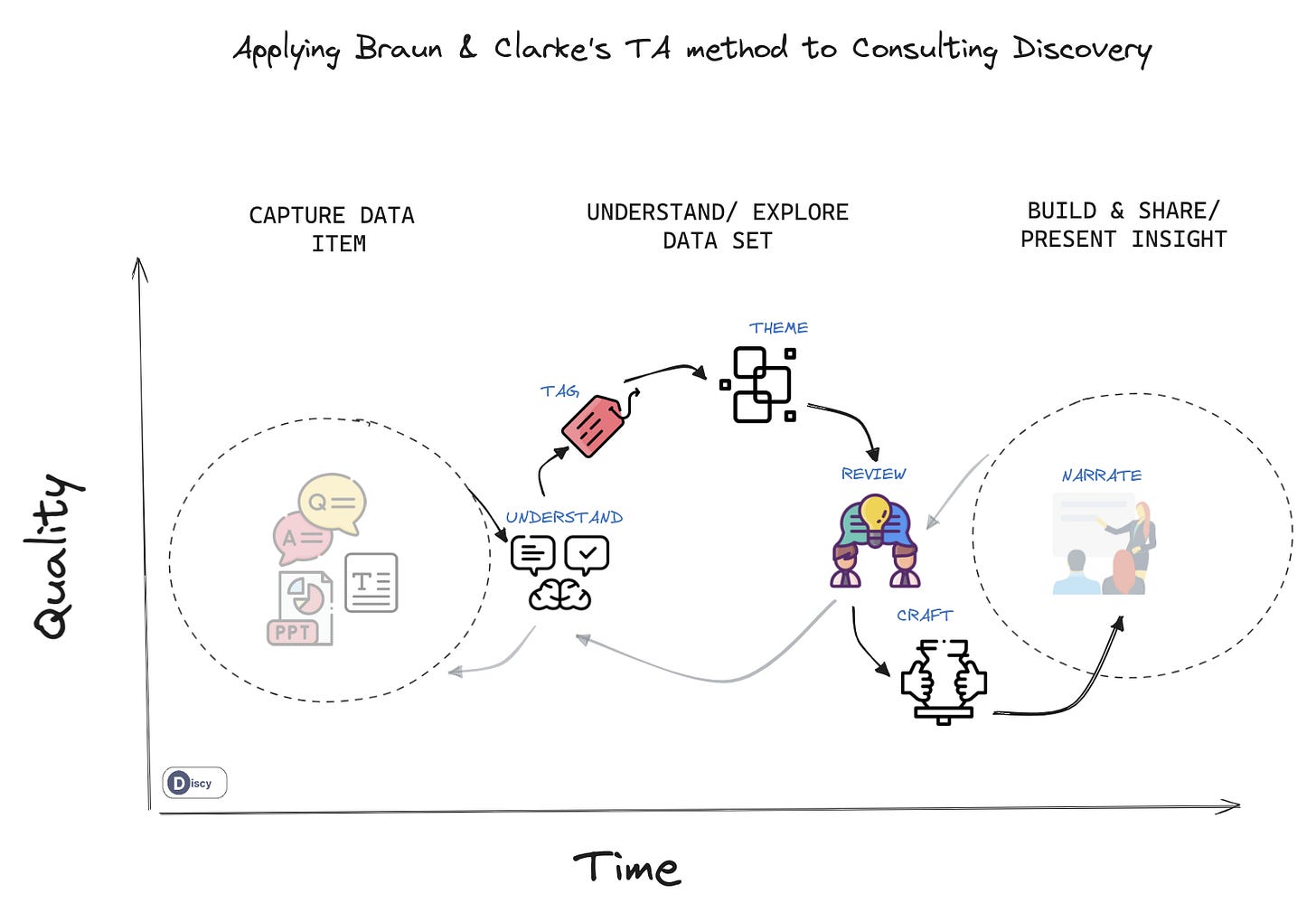Tips to make your qualitative analysis better.
There's a few ways to analyse qual data. Here we share our view on thematic analysis. A technique your team can hone to achieve even better results.
Tim and I swapped writer/ editor roles this week.
After our first post (starting our journey) and last week’s (update on product). I dive into ‘making your qualitative data purr’. I.e. Analysing qual data well in consulting & How Discy enhances this.
Research is old news in Consulting, but Qualitative Data Analysis (QDA) use is still ‘new’
Over time, approaches have evolved from…
…to also include QDA.
For obvious reasons.
So why QDA?
Like many things, within consulting, QDA is a mashup of terms and techniques.
Academia applies six broad kinds of QDA (Thematic, Content, Heuristic, Grounded, Discourse & Narrative). I’ll focus on Thematic Analysis (TA).
TA is the entry level technique that most consultants learn to use (even if not taught per-se). It’s a method to identify and analyse patterns in qualitative data (e.g. language), top-down or bottom-up.
You don't need to know much theory beforehand and it is flexible to use across most project types. Though most projects are top-down (e.g., market strategy, m&a, change, Tx assurance). E.g., what are experts saying about a market?, what are stakeholder thoughts on a process?.
A TA method for Consultants - Braun & Clarke
A clear method gives confidence to go faster with same or higher quality. When we think of TA, we adapt from one of Academia’s most popular approaches:
Our view is to pair process with human ingenuity and tailored tooling.
1) Understand
Teams should get cosy with the data before they start tagging. It’ll make for better insights. As teams usually share responsibility to understand the data - everyone needs to read actively. Have a plan, some guiding questions, and set aside time for conversations. Discussion lubricates thinking. Ideas often flow better in reaction to something!
Questions to ask:
"What am I trying to understand?"
"How do I sum up what I've read?"
"What does this remind me of?"
"Are there conflicts or contradictions?"
"Why does this matter?"
"What other questions should I be asking?"
Depending on project scope, you will be looking at what was said (semantics) or meant (latent).
Tip: Keep notes of the ideas that arise as you read and converse. Record & share audio notes.
2) Tag
This goes better if #1 is done. Teams should use the notes they took to tag their data, inclusively. Time box effort and tag potential patterns, gaps and ideas.
Being familiar with the dataset guards against shallow, generic or mundane observations.
3) Theme
Theming is subjective. You characterise themes based on significance:
Do they fit within your firm or project's conceptual framework (e.g., culture)
How frequently did they appear (e.g., stakeholder type, interview set)
Neglected themes (i.e., surprise absences)
Similar patterns from other projects
Alignment with project goals or hypotheses
A visual can help thinking (Mind-maps, boards, tables etc). But agree a similar format upfront for efficiency (for when the team combines its work). Consultants are a mix of visual, verbal and numerical thinkers!
4) Review
Themes should be reviewed to ensure they're coherent and distinct.
1st, remove or rehome stray tagged extracts. 2nd, verify if each theme truly reflects the dataset.
Questions to ask:
Do the themes make sense?
Does the data support the themes?
Is too much trying to fit into a theme?
If themes overlap, should they be separate?
Are there themes within themes (sub-themes)?
Are there other important themes missing?
Tip. Reworking themes is iterative and ongoing. Use a thematic map. Follow 80:20 principles!
5) Craft
At this point, themes are shaping into insights. Identify each theme’s story and how they sit together. Turn this into a snappy, concise, and impactful headline conclusion.
6) Narrate
Now, you can weave your insights into a moving argument. We’ll cover this and #5 in depth in a later post.
Final thoughts
Avoid using the questions asked of participants as themes. This can obscure real insights.
Make it a habit to record working sessions and calls. It helps to trace decisions. Discy does this whenever data is added or tagged on the platform.
We will cover sentiment analysis in a future post.
Subjectivity is essential in TA. But it is important to bring transparency to the team’s biases and assumptions. Use project kick-off for the team to note:
The assumptions, if any, they hold, about the discovery question.
Their values and life experiences that might shape how they read and interpret the data. This seems awkward, but it helps when you review.









